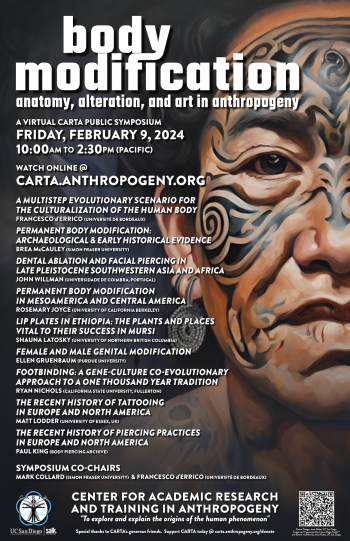Body Modification: Anatomy, Alteration, and Art in Anthropogeny
Mark Collard, Simon Fraser University
Francesco d'Errico, University of Bordeaux
Summary:
Permanent body modification is an intriguing phenomenon. It is regularly practiced by living humans but is not seen in other extant mammals. It is highly variable within and between cultures. It is also often both expensive and risky. All of these characteristics—its uniqueness, its variability, and its actual or potential costliness—make permanent body modification an important behavior for scientists to understand. However, the scientific study of permanent body modification is in its infancy. The goal of this symposium is to provide a snapshot of where we are at with regard to research on permanent body modification and to identify questions that should be prioritized over the next decade. The symposium will bring together academics from a number of disciplines as well as practitioners from the permanent body modification industry. We will cover a wide range of historical and contemporary permanent body modification practices, including but not limited to tattooing, piercing, finger amputation, and cranial modification. In addition to considering the ‘when’ and ‘where’ of permanent body modification, we will delve into the motivations behind this behavior, considering both the personal justifications offered by participants and the scientific hypotheses proposed to explain it.
Media for each talk can be played by clicking on icons in the table below, or by clicking on the individual talk titles below and then the attachment file at the bottom of the page.
| Speakers | Media | Session |
|---|---|---|
 Katerina Semendeferi  Mark Collard |
|
Welcome & Opening Remarks Welcome by CARTA Co-Director, Katerina Semendeferi. Opening remarks by Event Co-chair, Mark Collard. |
 Francesco d'Errico |
|
A multistep evolutionary scenario for the culturalization of the human body Our unique ability to culturalize our body has deep roots. We propose an evolutionary scenario for the culturalization of the human body that, although only relying on technologies that have left traces on the archaeological record, identify trends that may shed light on the evolution of ephemeral practices. This scenario starts 500-300 ka and identifies major tipping points at 140 ka, 70 ka and 45 ka, followed by an acceleration corresponding to the emergence of production economies. The logic... read more |
 Brea McCauley |
|
Permanent body modification: archaeological and early historical evidence Today, permanent body modification (PBM) is very popular. Studies suggest that well over a billion living people have experienced one or more types of PBM. But what is the history of PBM? When did the different types originate? Were they invented recently, or do they have a long history? Did they appear simultaneously or at different times? In this presentation, we shed some light on these questions. We begin by considering whether there is any evidence of PBM in non-human animals or our... read more |
 John Willman |
|
Dental ablation and facial piercing in Late Pleistocene southwestern Asia and Africa Bioarchaeological approaches to permanent body modification—such as tooth ablation, facial piercing, and cranial modification—among Pleistocene peoples are augmenting our understanding of social identities and population dynamics in the deep past. Recent analyses of an early Epipaleolithic skeleton, Ohalo II H2, from southwestern Asia and the Late Pleistocene/Early Holocene Oldupai (Olduvai) Hominid 1 skeleton from Tanzania provided dental evidence for permanent body modification. A... read more |
 Rosemary Joyce |
|
Permanent body modification in Mesoamerica and Central America Archaeological research provides the potential to examine cultural practices over long periods of time to begin to disentangle the motivations for their adoption, change, and abandonment. By focusing on a specific area-- the territory now included in Mexico and Central America-- this talk demonstrates how histories of body modification can illuminate shared identities that cross linguistic, ethnic, and political boundaries, and distinctions created within regional traditions and individual... read more |
 Shauna LaTosky |
|
Lip plates in Ethiopia: The plants and places vital to their success in Mursi In the literature on lip plates in Southern Ethiopia there has been a strong emphasis on their socio-cultural importance and little information about their biocultural significance. I propose that cultural keystone species theory and cultural keystone place theory could provide a useful frameworks for understanding relationships between the agro-pastoralist Mursi of Southern Ethiopia and the plant species and places that are integral to maintaining their cultural bodily practices. Keystone... read more |
 Ellen Gruenbaum |
|
Female and male genital modification This presentation offers an overview of the many forms of permanent genital modifications embedded in human cultures, where they occur, the reasons why, the archaeological investigations of origins, and future trends. Included are female clitoridectomy, excision, infibulation, and other practices that affect about five percent of females worldwide; and the male practices that affect one-third of males: circumcision, superincision, and subincision. Why have so many cultures invented and... read more |
 Ryan Nichols |
|
Footbinding: A gene-culture co-evolutionary approach to a one thousand year tradition "Footbinding" refers to a 1000-year-long practice in which ethnically Han Chinese families would modify the feet of young girls often by repeatedly wrapping the four small toes under the sole of the foot to maintain its small size, often breaking those toes in the process. Various explanations for the origins, maintenance, and cessation of footbinding have been proposed, and two stand out: the Labor Market Hypothesis and an Evolutionary Social Sciences Hypothesis. The purpose of this paper is... read more |
 Matt Lodder |
|
The recent history of tattooing in Europe and North America This presentation presents a new account of the development of professional tattooing in Britain and America since the late 19th century. Research based exclusively in primary sources reveals that the story of what kickstarted the creation of commercial tattooing, and what sustained it, ultimately becomes intelligible as a small and interconnected network of transnational artists and – crucially – clients. These newly clarified networks problematise both the date and form of the customary... read more |
 Paul King |
|
The recent history of piercing practices in Europe and North America Across continents, material evidence of body piercing jewelry abounds in the archeological record. However, the varying procedures and processes of piercing, healing, and stretching these wounds for adornment remains unfamiliar to most archeologists. This PowerPoint presentation discusses the early self-experimentations that led to the development of the Euro-American body piercing industry. From the late 19th throughout the 20th centuries shared personal correspondence, illustrations, and... read more |
 All Speakers  Francesco d'Errico  Pascal Gagneux |
|
Question & Answer Session and Closing Remarks Question and answer session with all speakers. Wrap-up by Event Co-chair, Francesco d'Errico. Closing remarks by CARTA Executive Co-Director, Pascal Gagneux. |
If you enjoy this event, please consider supporting CARTA's quest to explore and explain the human phenomenon.


